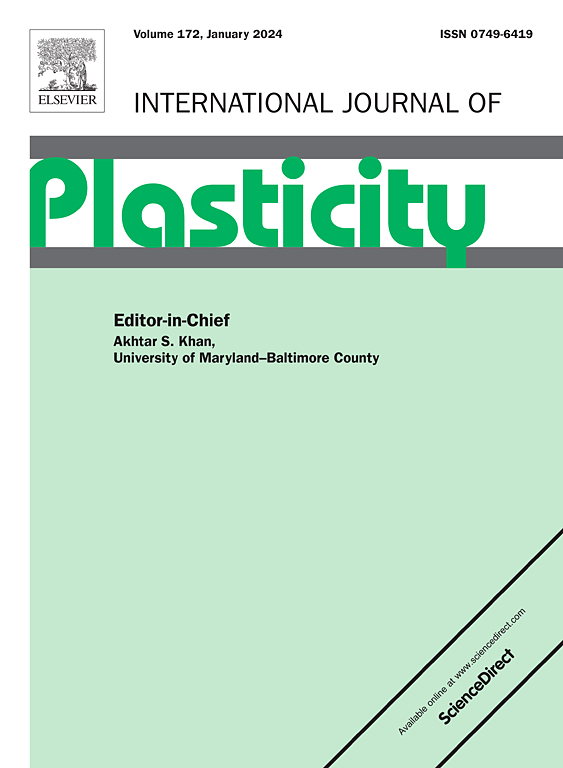3D interface size effects on slip transfer in Ti/Nb nanolaminates
IF 9.4
1区 材料科学
Q1 ENGINEERING, MECHANICAL
引用次数: 0
Abstract
Two-phase nanolaminates are well-renowned for achieving extraordinarily high strengths but at the sacrifice of reduced toughness and strain to failure. Recently ”thick” interfaces, or so called 3D interfaces, in Cu/Nb nanolaminates were experimentally shown to improve both of these mechanical properties. In this work, we study the effect of 3D interfaces in the hexagonal close packed (HCP)/body centered cubic (BCC) Ti/Nb nanolaminate system. Nanoindentation hardness testing suggests increased strength with the introduction of a 3D Ti–Nb interface and a positive size effect with increases in 3D interface thickness from 5 nm to 20 nm. To understand this effect from a single dislocation perspective, we present a phase-field dislocation dynamics (PFDD) model for multi-phase HCP/BCC systems. We employ the model to simulate stress-driven transfer of single dislocations across 3D Ti/Nb interfaces of various thicknesses. Our results show that the critical stress for slip transfer increases with the thickness of the interface. This positive size effect is stronger for transfer from basal or prismatic dislocations in the Ti layer to 110 dislocations in the Nb layer than the reverse. For this Ti/Nb system, a critical thickness of 2 nm is identified at which the asymmetry in slip transfer is minimized. This work showcases 3D interfaces as a beneficial microstructure modification to strengthen as well as reduce anisotropy in nanocrystalline materials containing HCP phases.
Ti/Nb纳米层合材料中三维界面尺寸对滑移转移的影响
两相纳米层合材料以获得极高的强度而闻名,但以降低韧性和应变为代价。最近,Cu/Nb纳米层合材料中的“厚”界面或所谓的3D界面被实验证明可以改善这两种机械性能。在这项工作中,我们研究了六角形紧密堆积(HCP)/体心立方(BCC) Ti/Nb纳米层合材料体系中三维界面的影响。纳米压痕硬度测试表明,3D Ti-Nb界面的引入增加了强度,3D界面厚度从5 nm增加到20 nm,产生了正的尺寸效应。为了从单一位错的角度理解这种影响,我们提出了多相HCP/BCC体系的相场位错动力学(PFDD)模型。我们利用该模型模拟了不同厚度的三维Ti/Nb界面上单位错的应力驱动传递。结果表明,滑移传递的临界应力随界面厚度的增大而增大。从Ti层的基底位错或棱柱位错到Nb层的110 < 111 > < 111 >位错的转移,这种正尺寸效应比相反的转移更强。对于该Ti/Nb体系,确定了2 nm的临界厚度,在此厚度下滑移转移的不对称性最小。这项工作展示了3D界面作为一种有益的微观结构改性,可以增强和减少含有HCP相的纳米晶材料的各向异性。
本文章由计算机程序翻译,如有差异,请以英文原文为准。
求助全文
约1分钟内获得全文
求助全文
来源期刊

International Journal of Plasticity
工程技术-材料科学:综合
CiteScore
15.30
自引率
26.50%
发文量
256
审稿时长
46 days
期刊介绍:
International Journal of Plasticity aims to present original research encompassing all facets of plastic deformation, damage, and fracture behavior in both isotropic and anisotropic solids. This includes exploring the thermodynamics of plasticity and fracture, continuum theory, and macroscopic as well as microscopic phenomena.
Topics of interest span the plastic behavior of single crystals and polycrystalline metals, ceramics, rocks, soils, composites, nanocrystalline and microelectronics materials, shape memory alloys, ferroelectric ceramics, thin films, and polymers. Additionally, the journal covers plasticity aspects of failure and fracture mechanics. Contributions involving significant experimental, numerical, or theoretical advancements that enhance the understanding of the plastic behavior of solids are particularly valued. Papers addressing the modeling of finite nonlinear elastic deformation, bearing similarities to the modeling of plastic deformation, are also welcomed.
 求助内容:
求助内容: 应助结果提醒方式:
应助结果提醒方式:


